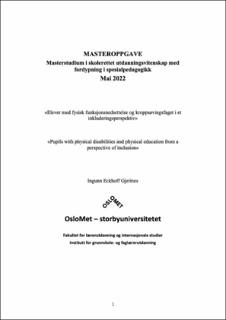| dc.description.abstract | Kroppsøving er et obligatorisk skolefag og i lys av en inkluderende fellesskole har alle elever rett på en tilpasset opplæring i faget (Haug, 2014, s. 18). I kroppsøvingsfaget viser det seg dog å være fordringsfullt å følge opp intensjonene om en inkluderende opplæring (Bredahl, 2012; Wilhelmsen & Sørensen, 2017). Studien til Svendby (2013) peker blant annet på et gap mellom retorikken om en inkluderende skole og det som erfares av funksjonsnedsatte elever i kroppsøvingsfaget. Elever med fysisk funksjonsnedsettelse har rett til en inkluderende opplæring i kroppsøvingsfaget og studien ønsker derfor å undersøke nærmere hvilke erfareringer de har med kroppsøvingsfaget. Det resulterte til følgende problemstilling: ««Hvilke erfaringer har elever i videregående opplæring med fysisk funksjonsnedsettelse med kroppsøvingsfaget». Problemstillingen tar for seg elever i videregående opplæring med fysisk funksjonsnedsettelse, og studien retter en spesiell oppmerksomhet mot de elevene som benytter rullestol i kroppsøvingsfaget. Formålet med studien er å rette søkelys på elevenes erfaringer med kroppsøvingsfagets faglige og sosiale fellesskap, deltakelse i kroppsøvingsundervisningen, samt deres opplevelse av medvirkning og utbytte av faget. I denne studien benyttes en kvalitativ metode med en hermeneutisk tilnærming. For å innhente studiens datamateriale ble det gjennomført fire forskningsintervju. Utvalget består av fire gutter i alderen 17-23 år hvor av alle sitter i rullestol. Ett av studiens inklusjonskriterier var at informantene har deltatt/deltar i ordinær kroppsøvingsvisning med bruk av rullestol. Resultatene av studien viser at elever med fysisk funksjonsnedsettelse har varierte erfaringer med kroppsøvingsfaget. Enkelte elever med fysisk funksjonsnedsettelse liker kroppsøvingsfaget svært godt, mens andre opplever at kroppsøvingsfaget domineres av ekskluderende praksiser. Studiens empiri viser at fysisk funksjonsnedsatte elever kan oppleve det mer utfordrende å ta del i det faglige og sosiale fellesskapet i kroppsøvingsfaget enn i andre skolefag. Ønske om å få delta i kroppsøvingsfaget ser ut til å dominere blant elever med funksjonsnedsettelse, og studien viser at informantene enten deltar i felles undervisning eller gjennomfører individuelt opplegg separert fra medelever. Funn fra studien viser at elever med fysisk funksjonsnedsettelse ofte erfarer å få medvirke inn i eget opplæringstilbud i kroppsøving, men dog kan dette være et resultat av at det ofte er elevene selv som må tilpasse kroppsøvingsundervisningen til egne forutsetninger. Basert på informantenes erfaringer knyttet til kroppsøvingsfagets utbytte ser det ut til at fysisk funksjonsnedsatte elever kan, i likhet med de uten funksjonsnedsettelse, oppleve det utfordrende å skulle beskrive hva de har lært og hva de skal lære i kroppsøvingsfaget.
Within the policy of an inclusive school all pupils have the right of an adapted and equal education in Physical Education (PE) (Haug, 2014, s. 18). It seems though demanding for the course physical education to follow up the intentions of an including education (Bredahl, 2012; Wilhelmsen & Sørensen, 2017). Svendby (2013) claims there is a gap between the rhetoric of inclusive schooling and what pupils with disabilities experience in physical education. Students with physical disabilities have the right to an inclusive education in physical education. This study will therefore examine which experience students with physical disabilities have in physical education. My study question is: “How do pupils with physical disabilities experience physical education in high school?” The study question focuses on pupils with physical disabilities in high school, specifically on pupils using a wheelchair in physical education. This study aims to put the pupils´ experiences with educational and social inclusion on the agenda, their role as participants in PE, and their experience of involvement and learning outcomes in the course. The study is based on a qualitative approach. The data got gathered by doing interviews with four participants. The selection consisted of four boys aged between 17 and 23 with physical disabilities. The recruitment required that the pupils actively participated in ordinary PE with a wheelchair. My findings indicate that pupils with physical disabilities have different types of experiences towards PE. Some pupils seem to like PE very much, while other pupils dislike PE because of multiple experiences of exclusion. This study shows that physically disabled pupils can find it more challenging to take part in the educational and social community in PE than in other school subjects. It seems like pupils with disabilities often want to participate in PE, and my findings indicate that participants in this study either participate in PE with the rest of the class or carry out individual programs separately from fellow pupils. Findings from this study show that pupils with physical disabilities often experience being able to involve and contribute into their own training provision in PE, but this may be a result of the fact that it is often the pupils themselves who must adapt activities to their own state of physical function. Based on my findings towards learning outcomes of PE, it appears that physically disabled pupils can find it challenging to describe what they have learned and what they are going learn in PE. | en_US |
